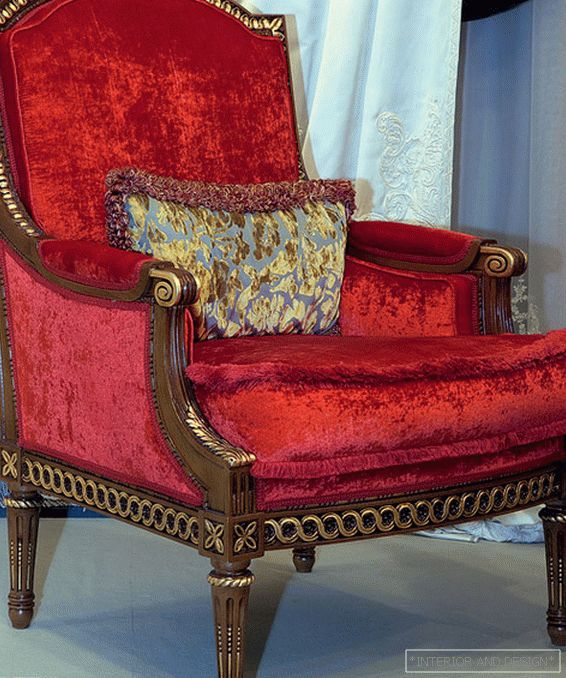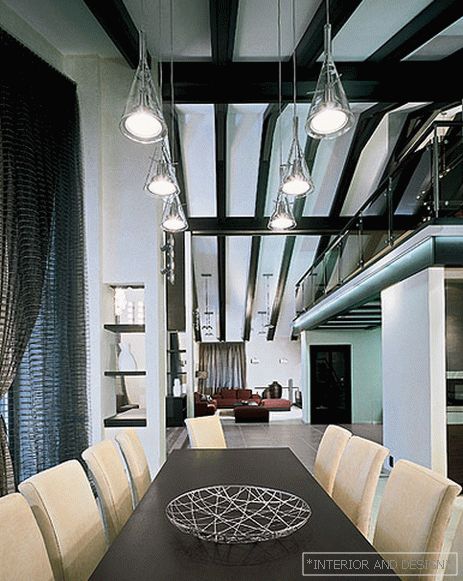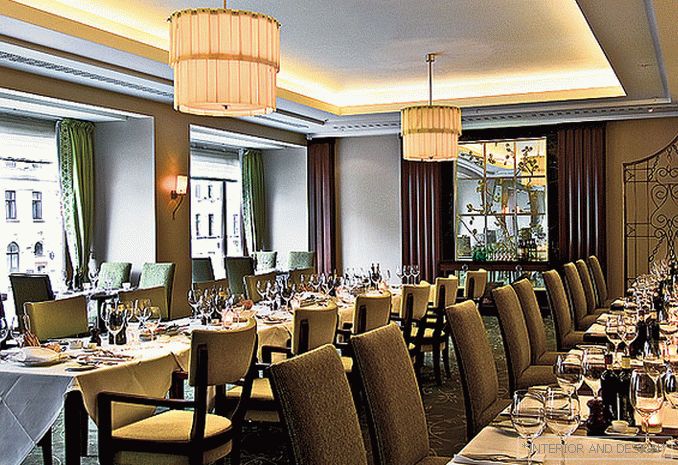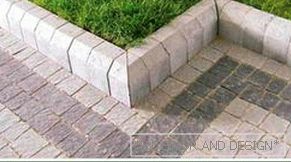 Today it is impossible to imagine the streets without borders. They can be seen everywhere: at bus stops, along highways and pedestrian paths, in parks and squares, around flowerbeds and lawns. Garden and summer cottage areas were no exception. The popularity of the curb can be explained by the fact that it surprisingly easily combines functionality and aesthetics.
Today it is impossible to imagine the streets without borders. They can be seen everywhere: at bus stops, along highways and pedestrian paths, in parks and squares, around flowerbeds and lawns. Garden and summer cottage areas were no exception. The popularity of the curb can be explained by the fact that it surprisingly easily combines functionality and aesthetics.
Content
- 1 What is a curbstone?
- 2 Advantages and disadvantages of curbstone
- 3 What are the dimensions of the curb stone?
- 4 Rules and features of styling
What is a curbstone?
Curbstone used for several hundred years. Its main purpose is to separate the pedestrian part of the road from the carriageway in order to protect pedestrians. For the production of this building material is mainly used semi-dry pressing technology. The border can be made of concrete, reinforced concrete, granite.
Curbstone application
Curb or side stone is widely used in the improvement of urban roads and sidewalks, garden and suburban areas. Depending on the application, the stone is divided. on several types:
-
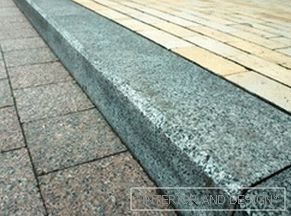 Road. It is used in the construction of urban roads. He distinguishes between the roadway and the pedestrian zone. Border strengthens tiles from the edges, increasing its service life. Also, the stone holds the roadway, preventing it from spreading under load.
Road. It is used in the construction of urban roads. He distinguishes between the roadway and the pedestrian zone. Border strengthens tiles from the edges, increasing its service life. Also, the stone holds the roadway, preventing it from spreading under load. - Trunk. Longer than the road. More durable and less susceptible to low temperatures than road.
- Pavement. It is used in the improvement of sidewalks in the city, squares, paths in city squares and parks, etc. It protects flowerbeds, paths, lawns from destruction and soil erosion. In size, it is slightly inferior road curb. It has a rich color range and variety of forms.
- Garden. Enough long, but not wide. It is used in the decoration of lawns, flowerbeds, in the arrangement of parks and squares.
- Lawn curb. It is used most often as an element of decorative decoration when breaking down garden and country beds and paths. It is lower than the sidewalk curb in height and weighs much less. It can be of different colors and shapes, helps prevent the destruction of the soil. The city is used in the organization of children's and parking areas, landscaping in front of shopping complexes and residential buildings.
- In addition to the improvement of roads and sidewalks, the curbstone serves to organizations of drains. With it, you can direct the water flow in the desired direction.
Advantages and disadvantages of curbstone
The main materials for the manufacture of curb stone are concrete and granite. Each of these materials has its advantages and disadvantages:
- The dignity of the concrete curb in his low price compared to granite.
- Hygroscopicity. To improve moisture resistance in concrete add various impurities. But even with additives, it absorbs up to 4% of moisture, while in granite this figure is no more than 0.45%.
-
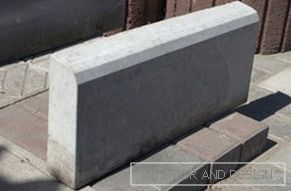 Frost resistance. At low temperatures, the absorbed water turns into ice and begins to break the material. Due to insufficient hygroscopicity, cracks appear faster on the concrete curb, it becomes brittle and begins to break down. Often, manufacturers of concrete curbs tend to increase production volumes, violating manufacturing technology. In order not to wait until the concrete mix has cooled, it is steamed by a special method. This leads to a decrease in frost resistance of concrete. The curb made in a similar way begins to collapse in the first year of operation. After 4-5 years, it will have to be completely changed. Granite curb can serve up to 40 years and only then will cracks and chips appear on it. Frequent replacement of a concrete curb leads to additional costs. In the end, the amount spent on it significantly exceeds the cost of a granite curb.
Frost resistance. At low temperatures, the absorbed water turns into ice and begins to break the material. Due to insufficient hygroscopicity, cracks appear faster on the concrete curb, it becomes brittle and begins to break down. Often, manufacturers of concrete curbs tend to increase production volumes, violating manufacturing technology. In order not to wait until the concrete mix has cooled, it is steamed by a special method. This leads to a decrease in frost resistance of concrete. The curb made in a similar way begins to collapse in the first year of operation. After 4-5 years, it will have to be completely changed. Granite curb can serve up to 40 years and only then will cracks and chips appear on it. Frequent replacement of a concrete curb leads to additional costs. In the end, the amount spent on it significantly exceeds the cost of a granite curb. - Natural stone looks more attractive than concrete. Over time, concrete curb getting dark and looks very unsightly.
What is the size of curbstone?
The most applicable curbstone with a length of 1 m. The height and width varies depending from the place of application. To separate roads from sidewalks and lawns, a 30 cm wide and 15 cm high curb is used. At public transport stops, a 30 cm wide curb is also used, and 18 cm high.
Also produce curbs with a length of 0.5 m to 3 m wide from 8 cm to 20 cm and a height of 8 cm to 60 cm. Each of them has its own GOST, which describes the scope.
Rules and features of styling
For laying you need tools:
- shovel;
- twine or thin rope;
- level;
- pegs;
- mallet;
- cement;
- sand;
- trumpet.
Curbstone laying проходит в several stages:
-
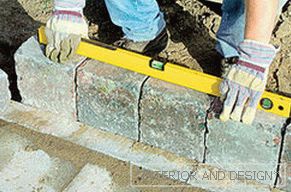 First with the help of twine and pegs mark and dig a trenchcorresponding to the size of the curb stone. Its depth is made a little more than the planned bedding of the stone. If the asphalt or tiled pavement is level with the ground, then the curb should be higher to prevent contamination of the roadway.
First with the help of twine and pegs mark and dig a trenchcorresponding to the size of the curb stone. Its depth is made a little more than the planned bedding of the stone. If the asphalt or tiled pavement is level with the ground, then the curb should be higher to prevent contamination of the roadway. - Trench bottom compacted by tamping and pour an even layer of concrete mix consisting of ¾ of sand and ¼ of cement.
- For a smooth laying of the curb, you should pull the string on which the stone will be exposed. It should be ensured that it does not fall aside. Align the curb mallet.
- If the curb stone has a front side, then you need to take this into account during laying. Border for flowerbeds fit "Face" out, for the track - inside.
- For strength, curbstones are fastened to the outside with a mixture of cement and sand.
No wonder the work on laying curbstone are considered the final stage in the improvement of the territory. The border adds an element of completeness to the overall look of the upgraded seat. it universal building material. Possessing the ability to save pavement and soil from destruction, it is not without aesthetic qualities and is able to decorate both a garden plot and city streets.

